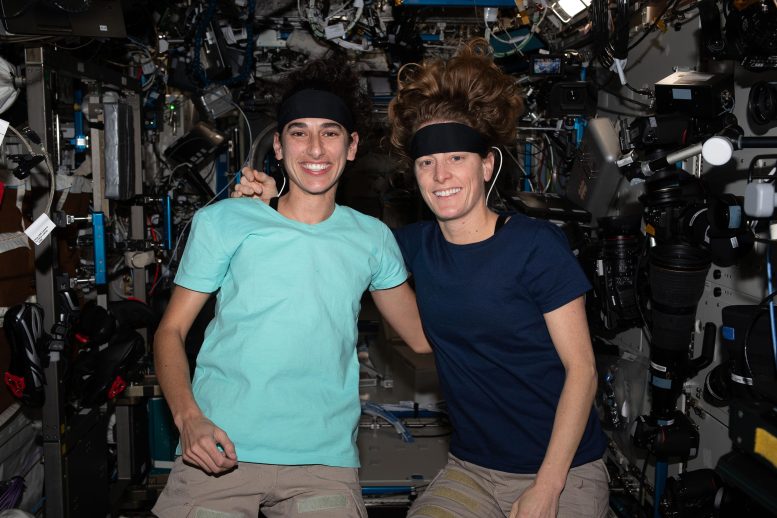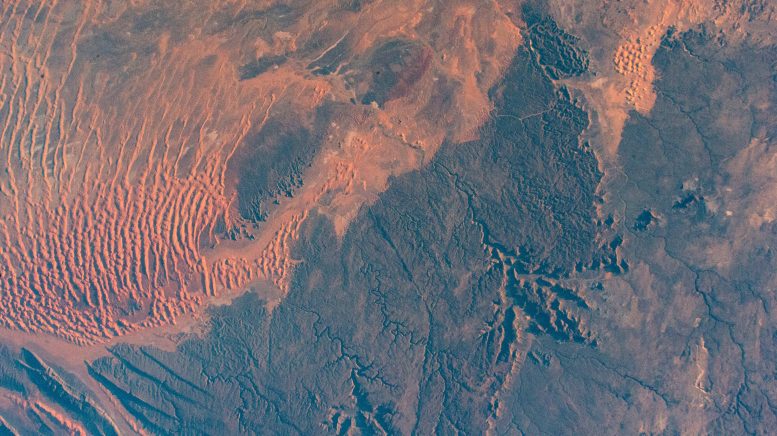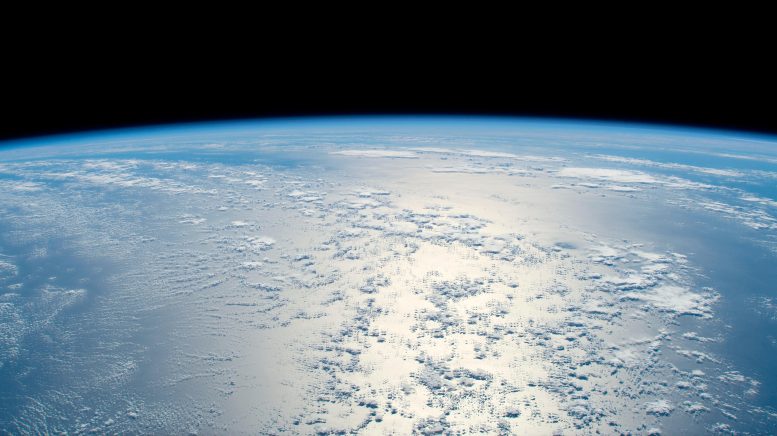Cutting-Edge Biology and Fluid Physics Research on the Space Station
The sun’s glint beams off a tranquil, blue Atlantic Ocean in this photograph from the International Space Station as it orbited 261 miles above and east of The Bahamas. Credit: NASA
Space biology and life support maintenance were the main focus for the Expedition 70 crew on Tuesday, January 9. The orbital residents aboard the International Space Station also studied future piloting techniques and fluid physics rounding out the research schedule.
NASA astronauts Loral O’Hara and Jasmin Moghbeli joined Commander Andreas Mogensen from ESA (European Space Agency) for biology research inside the Kibo laboratory module. The trio worked during the morning in Kibo’s Life Science Glovebox to learn how microgravity affects reproductive health and bone loss.
In the afternoon, O’Hara removed the Bio-Monitor vest and headband she was wearing that are demonstrating the ability to comfortably monitor and record an astronaut’s health data. Moghbeli inspected orbital plumbing gear in the orbital outpost’s Roscosmos segment. Mogensen ended his shift reviewing procedures for photographing the Moon illuminated by light reflected from Earth.

(From left) Expedition 70 Flight Engineers Jasmin Moghbeli and Loral O’Hara, both from NASA, wear Bio-Monitor headbands packed with sensors that monitor an astronaut’s health and physiological parameters while minimally interfering with their crew activities. Credit: NASA
Flight Engineer Satoshi Furukawa from JAXA (Japan Aerospace Exploration Agency) spent his day primarily servicing life support hardware and science gear. Furukawa’s main task took place inside the Columbus laboratory module as he connected and disconnected internal thermal control components. Afterward, he removed a carbon dioxide incubator controller from inside the Space Automated Bioproduct Laboratory, a life science and physics research facility.
Cosmonaut Nikolai Chub worked throughout Tuesday on a pair of different experiments for Roscosmos. He first wore a cap filled with sensors that monitored his reactions as he practiced futuristic spacecraft and robotic piloting techniques on a computer. Next, he studied how liquids behave in microgravity conditions including temperature changes and electrical and magnetic fields.

Sand dunes, sandstone plateaus, and rocky platforms that comprise the Tassili N’Ajjer National Park in the southeastern portion of Algeria are pictured from the International Space Station as it orbited 261 miles above the Sahara. Credit: NASA
Veteran cosmonaut and five-time station resident Oleg Kononenko spent Tuesday inspecting and photographing sections inside the Zvezda service module. Flight Engineer Konstantin Borisov continued working on drill batteries then inspected and photographed structural elements inside the Nauka and Zarya modules.
The Cygnus space freighter completed its stay in space when it reentered Earth’s atmosphere at 1:22 p.m. EDT today for a fiery, but safe destruction over the Pacific Ocean. Cygnus departed the orbital lab on December 22, after four-and-a-half months berthed to the station’s Unity module. The private resupply ship from Northrop Grumman launched over 8,200 pounds of science and cargo to the Expedition 70 crew on August 1 from Wallops Flight Facility in Virginia.

The sun’s glint beams off a tranquil, blue Atlantic Ocean in this photograph from the International Space Station as it orbited 261 miles above and east of The Bahamas. Credit: NASA
Space biology and life support maintenance were the main focus for the Expedition 70 crew on Tuesday, January 9. The orbital residents aboard the International Space Station also studied future piloting techniques and fluid physics rounding out the research schedule.
NASA astronauts Loral O’Hara and Jasmin Moghbeli joined Commander Andreas Mogensen from ESA (European Space Agency) for biology research inside the Kibo laboratory module. The trio worked during the morning in Kibo’s Life Science Glovebox to learn how microgravity affects reproductive health and bone loss.
In the afternoon, O’Hara removed the Bio-Monitor vest and headband she was wearing that are demonstrating the ability to comfortably monitor and record an astronaut’s health data. Moghbeli inspected orbital plumbing gear in the orbital outpost’s Roscosmos segment. Mogensen ended his shift reviewing procedures for photographing the Moon illuminated by light reflected from Earth.

(From left) Expedition 70 Flight Engineers Jasmin Moghbeli and Loral O’Hara, both from NASA, wear Bio-Monitor headbands packed with sensors that monitor an astronaut’s health and physiological parameters while minimally interfering with their crew activities. Credit: NASA
Flight Engineer Satoshi Furukawa from JAXA (Japan Aerospace Exploration Agency) spent his day primarily servicing life support hardware and science gear. Furukawa’s main task took place inside the Columbus laboratory module as he connected and disconnected internal thermal control components. Afterward, he removed a carbon dioxide incubator controller from inside the Space Automated Bioproduct Laboratory, a life science and physics research facility.
Cosmonaut Nikolai Chub worked throughout Tuesday on a pair of different experiments for Roscosmos. He first wore a cap filled with sensors that monitored his reactions as he practiced futuristic spacecraft and robotic piloting techniques on a computer. Next, he studied how liquids behave in microgravity conditions including temperature changes and electrical and magnetic fields.

Sand dunes, sandstone plateaus, and rocky platforms that comprise the Tassili N’Ajjer National Park in the southeastern portion of Algeria are pictured from the International Space Station as it orbited 261 miles above the Sahara. Credit: NASA
Veteran cosmonaut and five-time station resident Oleg Kononenko spent Tuesday inspecting and photographing sections inside the Zvezda service module. Flight Engineer Konstantin Borisov continued working on drill batteries then inspected and photographed structural elements inside the Nauka and Zarya modules.
The Cygnus space freighter completed its stay in space when it reentered Earth’s atmosphere at 1:22 p.m. EDT today for a fiery, but safe destruction over the Pacific Ocean. Cygnus departed the orbital lab on December 22, after four-and-a-half months berthed to the station’s Unity module. The private resupply ship from Northrop Grumman launched over 8,200 pounds of science and cargo to the Expedition 70 crew on August 1 from Wallops Flight Facility in Virginia.
